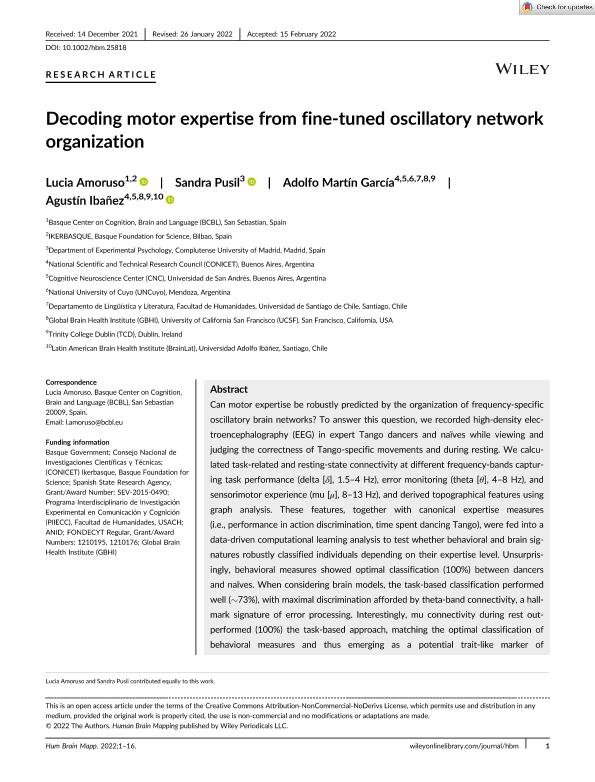Artículo
Decoding motor expertise from fine-tuned oscillatory network organization
Fecha de publicación:
06/2022
Editorial:
Wiley-liss, div John Wiley & Sons Inc.
Revista:
Human Brain Mapping
ISSN:
1065-9471
Idioma:
Inglés
Tipo de recurso:
Artículo publicado
Clasificación temática:
Resumen
Can motor expertise be robustly predicted by the organization of frequency-specific oscillatory brain networks? To answer this question, we recorded high-density electroencephalography (EEG) in expert Tango dancers and naïves while viewing and judging the correctness of Tango-specific movements and during resting. We calculated task-related and resting-state connectivity at different frequency-bands capturing task performance (delta [δ], 1.5–4 Hz), error monitoring (theta [θ], 4–8 Hz), and sensorimotor experience (mu [μ], 8–13 Hz), and derived topographical features using graph analysis. These features, together with canonical expertise measures (i.e., performance in action discrimination, time spent dancing Tango), were fed into a data-driven computational learning analysis to test whether behavioral and brain signatures robustly classified individuals depending on their expertise level. Unsurprisingly, behavioral measures showed optimal classification (100%) between dancers and naïves. When considering brain models, the task-based classification performed well (~73%), with maximal discrimination afforded by theta-band connectivity, a hallmark signature of error processing. Interestingly, mu connectivity during rest outperformed (100%) the task-based approach, matching the optimal classification of behavioral measures and thus emerging as a potential trait-like marker of sensorimotor network tuning by intense training. Overall, our findings underscore the power of fine-tuned oscillatory network signatures for capturing expertise-related differences and their potential value in the neuroprognosis of learning outcomes.
Archivos asociados
Licencia
Identificadores
Colecciones
Articulos(SEDE CENTRAL)
Articulos de SEDE CENTRAL
Articulos de SEDE CENTRAL
Citación
Amoruso, Lucía; Pusil, Sandra; García, Adolfo Martín; Ibañez, Agustin Mariano; Decoding motor expertise from fine-tuned oscillatory network organization; Wiley-liss, div John Wiley & Sons Inc.; Human Brain Mapping; 43; 9; 6-2022; 2817-2832
Compartir
Altmétricas




